26th August, 2025
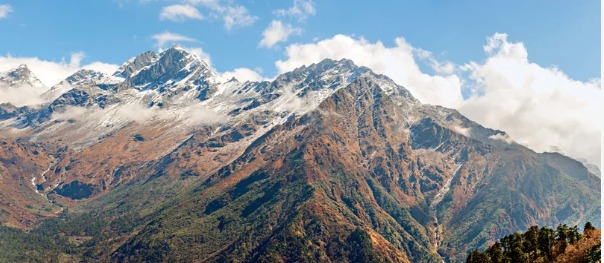
Mar 01, 2024
Mera Peak Climbing In April
- Why Mera Peak Climbing In April
- How Difficult To Climb Mera Peak In April
- I Never Climbed a Mountain. Can I Climb Mera Peak?
- Mera Peak Cost
- Highlights of Mera Climbing in April
- Can I Climb Mera Peak Without a Guide
- Can I Hire Equipment from Khare
- Solo Climb to Mera Peak
- What Should I Pack for Mera Peak Climbing In April
- Altitude Sickness and Acclimatization
- Mera Peak Successful Tips
- Conclusion
- Mera Peak Climbing Packages
Climbing Mera Peak in April offers an exhilarating adventure amidst favorable weather conditions and breathtaking Himalayan vistas. April marks the beginning of the peak climbing season in Nepal, making it an ideal time to conquer Mera Peak, standing tall at 6,476 meters (21,247 feet).
During April, climbers can expect stable weather with clear skies and mild temperatures, especially in the mornings and early afternoons. This provides excellent visibility for enjoying panoramic views of Everest, Lhotse, Makalu, and other surrounding peaks from the summit of Mera Peak. The weather conditions in April also contribute to safer and more predictable climbing conditions on the mountain.
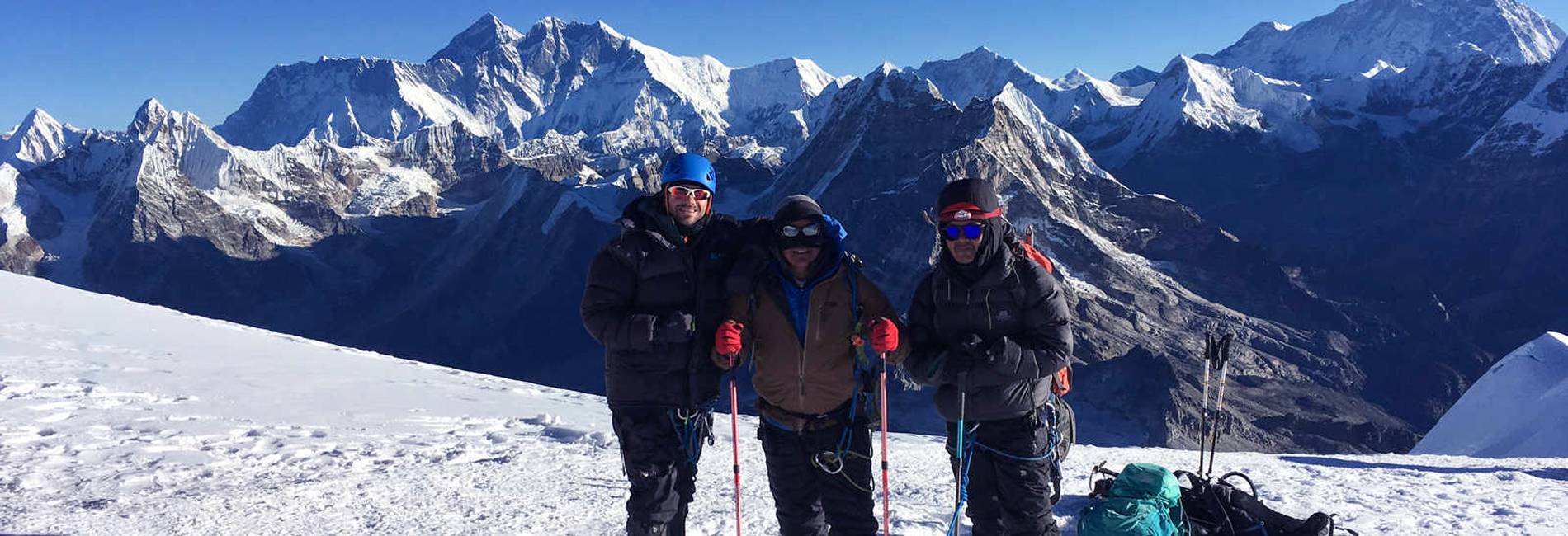
MERA PEAK CLIMBING
Mera Peak Climbing is an exhilarating adventure in Nepal that gives you an opportunity to reach the summit of Mera Peak at more than 6400m above sea level. Actually, it is the highest climbing (w...
The trek to Mera Peak in April begins with a scenic flight from Kathmandu to Lukla, followed by a trek through the picturesque Hinku Valley. The valley comes alive with blooming rhododendrons and other alpine flora, adding a vibrant touch to the journey. Sherpa villages along the way offer cultural insights and warm hospitality, enhancing the overall trekking experience.
Climbing Mera Peak involves ascending through rugged terrain, crossing glaciers, and making a final push up a steep snow slope to reach the summit. These challenges are mitigated by the favorable weather conditions and the experience of climbing during the peak season, which ensures well-established routes and support from experienced guides.
April also sees an increase in the number of climbers attempting Mera Peak, creating a vibrant atmosphere at base camps and high camps along the route. This provides an opportunity to meet fellow climbers from around the world and share in the camaraderie of pursuing a common goal.
Overall, climbing Mera Peak in April promises an unforgettable adventure filled with natural beauty, cultural immersion, and the thrill of conquering a Himalayan summit. Whether you're an experienced mountaineer or embarking on your first high-altitude climb, April offers optimal conditions to achieve your Himalayan adventure dreams on Mera Peak.

MERA PEAK EXPEDITION 13 DAYS
Mera Peak is one of the most popular and highest trekking peaks in Nepal, standing at 6,476 meters. The Mera Peak expedition is a 13-day trek that takes you through some of the most breathtaking scene...
Why Mera Peak Climbing In April
April is widely regarded as one of the best months for climbing Mera Peak due to favorable weather conditions and stunning scenery. As Nepal's peak climbing season begins, April offers clear skies, mild temperatures, and stable weather patterns, making it ideal for mountaineering. The days are longer, providing ample daylight hours for trekking and climbing activities.
Climbers in April can enjoy breathtaking views of the Himalayan giants, including Everest, Lhotse, and Makalu, from Mera Peak's summit. The trekking routes through the Hinku Valley are adorned with colorful rhododendron blooms and lush vegetation, enhancing the scenic beauty of the journey. Additionally, the increased number of climbers during this season creates a vibrant atmosphere at base camps and high camps, fostering a sense of camaraderie among fellow adventurers.
How Difficult To Climb Mera Peak In April
Climbing Mera Peak in April presents moderate challenges that require physical fitness, basic mountaineering skills, and proper acclimatization. At 6,476 meters (21,247 feet), Mera Peak is Nepal's highest trekking peak and involves technical elements such as glacier crossings and a final steep ascent to the summit.
April conditions typically offer stable weather with clear skies, reducing the risk of adverse weather-related challenges. However, climbers must be prepared for cold temperatures, especially at higher altitudes, and potential high-altitude effects such as altitude sickness.
While Mera Peak is considered suitable for climbers with limited mountaineering experience, it is essential to undertake thorough preparation. This includes physical conditioning, altitude acclimatization, and familiarity with basic mountaineering techniques such as using crampons and ice axes.
I Never Climbed a Mountain. Can I Climb Mera Peak?
Climbing Mera Peak is achievable for individuals with no prior mountain climbing experience, provided they undergo proper training, preparation, and guidance. While Mera Peak does not require extensive technical skills, climbers should possess a good level of physical fitness and be prepared for the challenges of high-altitude trekking.
Joining a guided expedition led by experienced mountaineers significantly increases the chances of a successful summit. Guides provide essential instruction on mountaineering techniques, safety protocols, and route navigation, ensuring climbers feel supported throughout the journey.
Novice climbers should dedicate time to physical conditioning, focusing on cardiovascular endurance, strength training, and altitude acclimatization. Practice hikes and treks at high altitudes help familiarize climbers with the demands of trekking in the Himalayas and prepare them for the rigors of summiting Mera Peak.
With proper preparation, determination, and support from experienced guides, novice climbers can conquer Mera Peak and experience the thrill of standing atop one of Nepal's iconic Himalayan peaks.
Mera Peak Cost
The cost of climbing Mera Peak varies depending on several factors, including the chosen route, duration of the expedition, services included, and the trekking agency or guide company selected. Here are some cost considerations for climbing Mera Peak:
- Permit Fees: Climbing permits are required for Mera Peak and are issued by the Nepal Mountaineering Association (NMA). The cost of permits varies for different seasons and nationalities.
- Guide and Porter Fees: Hiring experienced guides and porters is recommended for safety and logistical support. Guide fees include their expertise, assistance with route navigation, and ensuring safety during the climb.
- Equipment Rental: Climbers may need to rent or purchase mountaineering equipment such as crampons, ice axes, harnesses, and helmets. Rental costs depend on the quality and duration of equipment use.
- Accommodation and Meals: Accommodation during the trek includes teahouses or camping at base camps and high camps. Meals typically consist of local cuisine and cater to dietary preferences. The cost of accommodation and meals varies depending on the trekking route and services provided.
- Transportation: Costs include domestic flights from Kathmandu to Lukla, the starting point for the trek to Mera Peak. Transportation from Lukla to the trek's endpoint and back to Kathmandu is also factored into the overall expedition cost.
- Miscellaneous Expenses: Additional expenses may include travel insurance, visa fees, tips for guides and porters, and personal spending on snacks, beverages, and souvenirs.
Overall, budgeting for climbing Mera Peak should account for permit fees, guide services, equipment rental, accommodation, meals, transportation, and additional expenses. It's advisable to obtain quotes from multiple trekking agencies, compare services offered, and ensure transparency regarding inclusions and exclusions in the expedition cost.

MERA PEAK CLIMBING 17 DAYS
This is an excellent opportunity to climb Nepal’s highest peak without having to obtain a permit (6,476m/21,190ft). From the summit, you will have stunning views of several 8000m plus peaks, such as E...
Highlights of Mera Climbing in April
Climbing Mera Peak in April offers a multitude of highlights that make it an exceptional experience for mountaineers and adventurers. The month of April signifies the beginning of Nepal's peak climbing season, characterized by stable weather, clear skies, and mild temperatures—ideal conditions for summiting Mera Peak, Nepal's highest trekking peak at 6,476 meters (21,247 feet).
One of the primary highlights of climbing Mera Peak in April is the panoramic views from the summit, which include some of the world's highest peaks such as Everest, Lhotse, and Makalu. The trek through the picturesque Hinku Valley is adorned with blooming rhododendrons and other alpine flora, adding a splash of color to the rugged landscape. The journey also offers cultural insights as climbers pass through Sherpa villages, experiencing warm hospitality and traditional mountain life.
The camaraderie among climbers during April adds to the adventure, with base camps and high camps buzzing with activity as mountaineers from around the globe converge to tackle the peak. Whether it's the thrill of the climb, the natural beauty, or the cultural immersion, climbing Mera Peak in April promises unforgettable memories and a sense of achievement amidst the Himalayan splendor.
Can I Climb Mera Peak Without a Guide
While it's technically possible to climb Mera Peak without a guide, it is strongly recommended to hire an experienced guide or join a guided expedition for several important reasons. Mera Peak, although considered a non-technical climb, involves navigating glaciers, crossing crevasses, and ascending steep snow slopes—activities that require knowledge of mountaineering techniques and familiarity with the route.
Experienced guides provide invaluable support and ensure safety throughout the expedition. They offer expertise in route finding, assess weather conditions, and manage logistics such as accommodation, meals, and equipment. Guides also play a crucial role in altitude management and emergency response, reducing risks associated with high-altitude climbing.
Moreover, climbing Mera Peak with a guide enhances the overall experience by providing cultural insights, local knowledge, and camaraderie among climbers. Guides are trained to handle various situations that may arise during the climb, ensuring a smoother and more enjoyable journey to the summit.
While some experienced climbers may choose to attempt Mera Peak independently, it's essential to have comprehensive mountaineering skills, proper equipment, and thorough preparation for high-altitude challenges. For most climbers, especially those new to Himalayan mountaineering, hiring a guide is the recommended and safer option to maximize the chances of a successful and memorable climb.
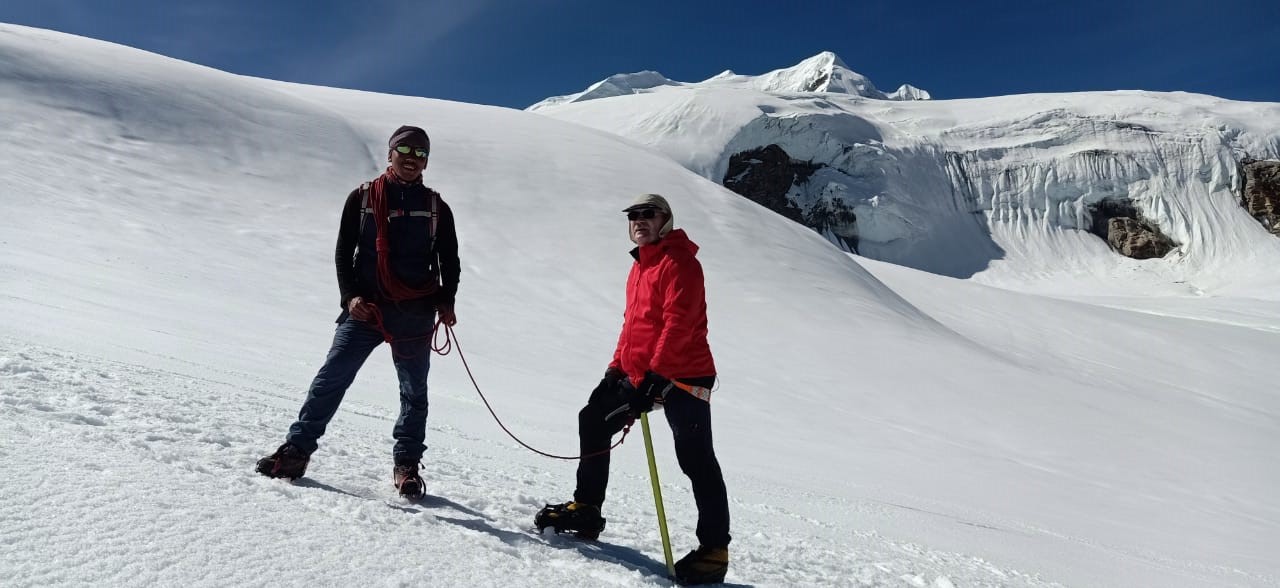
Mera Peak Climbing 20 Days
This is a chance to go climbing without the necessary permits that most climbing expeditions require in Nepal. Mera Peak fits the bill perfectly and at (6,476m/21,190ft) you will have spectacular view...
Can I Hire Equipment from Khare
Khare, located at approximately 5,000 meters (16,404 feet), serves as the last village and base camp before ascending to Mera Peak. While Khare offers basic lodging and food options, the availability of rental equipment may be limited and not always guaranteed.
It's advisable to bring essential mountaineering equipment such as crampons, ice axes, harnesses, helmets, and appropriate clothing from Kathmandu or hire them from reputable trekking agencies before arriving in Khare. This ensures climbers have the necessary gear tailored to their size and requirements for the climb.
Renting equipment in Khare may be possible but is subject to availability and quality. It's recommended to check with local guides or trekking agencies beforehand to confirm equipment rental options and make arrangements accordingly.
Solo Climb to Mera Peak
Embarking on a solo climb to Mera Peak is a challenging endeavor that requires extensive mountaineering experience, physical fitness, and thorough preparation. Solo climbers must be proficient in glacier travel, route navigation, and high-altitude acclimatization to safely tackle the ascent and descent.
While it's technically feasible to climb Mera Peak solo, it's important to consider the inherent risks and challenges involved. Solo climbers assume full responsibility for their safety, decision-making, and emergency response in remote and high-altitude environments.
Joining a guided expedition or climbing with experienced partners is generally recommended for safety, logistical support, and camaraderie during the climb. Experienced guides provide valuable assistance in route planning, equipment management, and emergency protocols, enhancing the overall safety and success of the expedition.
Solo climbers must obtain necessary permits, adhere to local regulations, and notify local authorities or trekking agencies of their itinerary and plans. Proper planning, self-sufficiency, and respect for the natural environment are essential for a successful solo climb to Mera Peak.
Before attempting a solo climb, evaluate personal skills, experience, and readiness for the physical and mental challenges of high-altitude mountaineering. Seek advice from experienced climbers or mountaineering organizations to ensure preparedness and safety during the solo expedition.

MERA PEAK CLIMBING 15 DAYS
The Mera Peak Expedition is a 15-day trek that takes you through some of the most stunning landscapes and challenging trails in Nepal. Mera Peak is the highest trekking peak in Nepal, standing at 6,47...
What Should I Pack for Mera Peak Climbing In April
Packing essentials for climbing Mera Peak in April requires careful consideration of weather conditions, terrain challenges, and high-altitude demands. Here’s a list of essential items:
- Clothing: Layering is key. Pack thermal base layers, insulated jackets, waterproof outer shells, trekking pants, gloves, hats, and a buff or scarf to protect against cold and wind.
- Footwear: Sturdy, waterproof trekking boots with good ankle support and crampon-compatible soles are essential. Also, pack warm socks and gaiters for snow and ice.
- Mountaineering Gear: Crampons, ice axe, harness, helmet, and trekking poles for glacier crossings and steep ascents.
- Sleeping Gear: A four-season sleeping bag suitable for sub-zero temperatures and a sleeping pad for insulation.
- Personal Gear: Headlamp with extra batteries, sunglasses with UV protection, sunscreen (SPF 30+), lip balm, toiletries, and a lightweight towel.
- Medical Kit: Include medications for altitude sickness, first aid supplies, blister treatment, and personal prescriptions.
- Climbing Accessories: Carry a duffel bag or backpack for gear transport, a water bottle or hydration system, and snacks for energy.
- Documents: Passport, permits (issued by NMA), travel insurance details, and emergency contacts.
Preparing and packing well ensures comfort, safety, and readiness for the challenges of climbing Mera Peak in April.
Altitude Sickness and Acclimatization
Altitude sickness, or acute mountain sickness (AMS), can affect climbers at high altitudes like Mera Peak. Symptoms include headache, nausea, dizziness, and fatigue. Proper acclimatization is crucial to mitigate AMS risks.
Climbers should ascend gradually, allowing time for their bodies to adjust to reduced oxygen levels. Schedule acclimatization days during the trek to higher altitudes, ascending no more than 300-500 meters per day above 3,000 meters. Stay hydrated, eat nutritious meals, avoid alcohol and smoking, and monitor symptoms closely.
If experiencing AMS symptoms, descend immediately to lower altitudes. Rest, hydration, and proper acclimatization are key to a safe and successful climb on Mera Peak.

MERA PEAK SUMMIT 10 DAYS
This is a chance to go climbing without the necessary permits that most climbing expeditions require in Nepal. Mera Peak fits the bill perfectly and at (6,476m/21,190ft) you will have spectacular view...
Mera Peak Successful Tips
Achieving a successful climb on Mera Peak in April requires thorough preparation, physical conditioning, and strategic planning:
- Physical Fitness: Train in advance with cardiovascular exercises, strength training, and hikes to build endurance and stamina.
- Acclimatization: Gradually acclimate to higher altitudes during the trek, allowing the body time to adjust and reduce the risk of altitude sickness.
- Weather Monitoring: Stay updated on weather forecasts and conditions. Start early for summit attempts to maximize daylight and avoid afternoon storms.
- Hydration and Nutrition: Drink plenty of water and eat high-energy foods to fuel your climb and aid in recovery.
- Teamwork and Support: Join a guided expedition or climb with experienced partners for safety, route navigation, and logistical support.
- Safety Precautions: Follow safety protocols, use proper mountaineering gear, and listen to your guide’s instructions at all times.
- Respect the Environment: Practice Leave No Trace principles, respecting local culture, and minimizing environmental impact.
By preparing diligently and adhering to these tips, climbers can increase their chances of a safe, enjoyable, and successful climb to Mera Peak in April.
Conclusion
Climbing Mera Peak in April promises an unforgettable adventure amidst the majestic Himalayan landscapes. With stable weather conditions, clear skies, and blooming rhododendrons along the trekking route, April offers optimal conditions for summiting Nepal's highest trekking peak. Proper preparation, including packing essential gear, understanding altitude sickness, and acclimatization strategies, is crucial for a safe and successful climb.
Whether you're a seasoned mountaineer or embarking on your first high-altitude adventure, climbing Mera Peak in April rewards climbers with panoramic views of Everest and surrounding peaks, cultural encounters with Sherpa communities, and a sense of accomplishment upon reaching the summit. Embrace the challenge, respect the environment, and savor every moment of this extraordinary Himalayan expedition to Mera Peak in April.
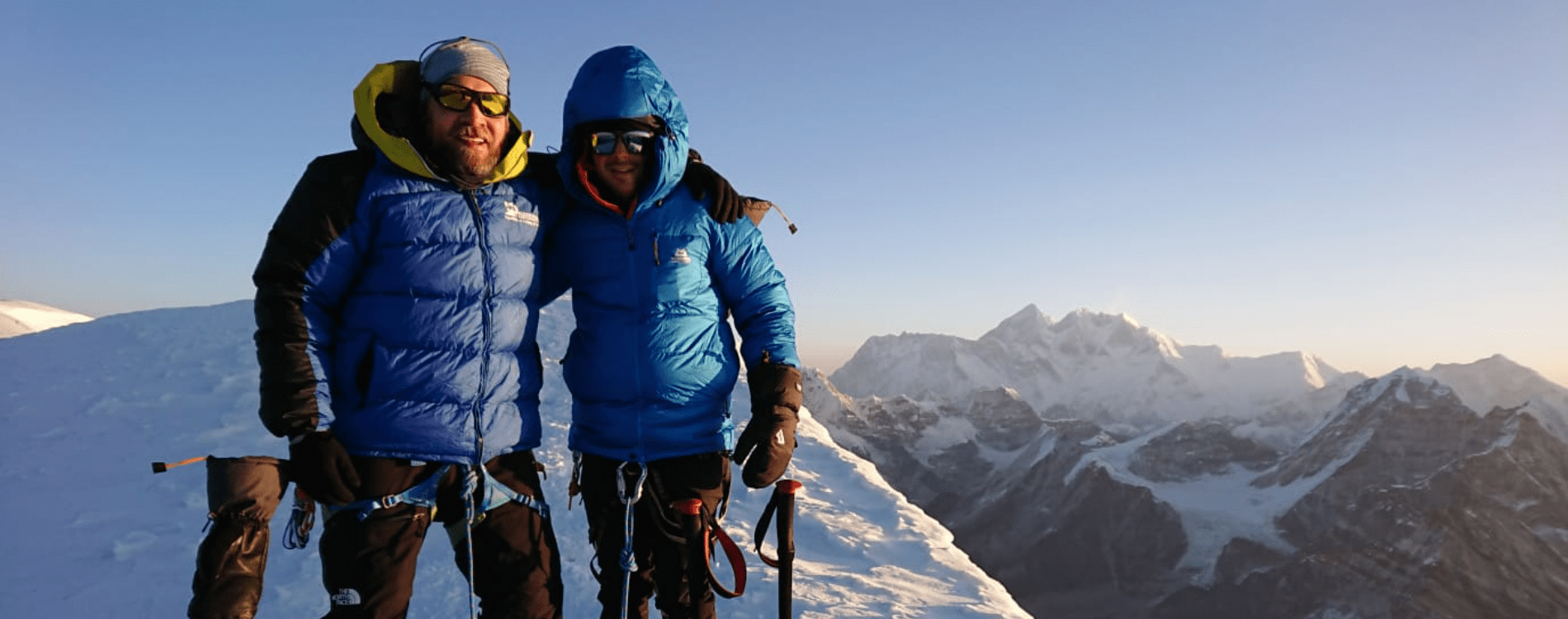
MERA PEAK SUMMIT RETURN BY HELICOPTER
Mera Peak Climbing Just in 12 Days Return By Helicopter to Lukla and flight back Kathmandu.This is an excellent opportunity to climb Nepal’s highest peak without having to obtain a permit (6,476m/21,1...
Mera Peak Climbing Packages
Mera Peak Summit Return By Helicopter
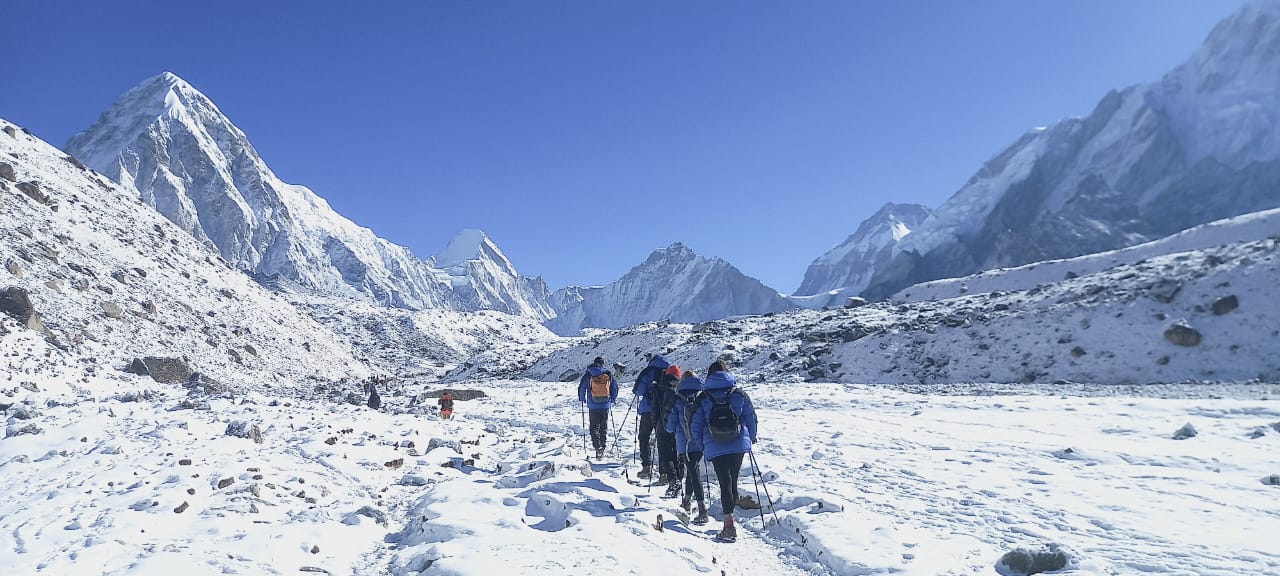
MERA AND ISLAND PEAK CLIMBING
Embark on a thrilling mountaineering adventure like no other with the Mera and Island Peak Climbing expedition crafted by We Sherpa Expedition and Trekking. This exclusive package is designed for adve...
Any Questions? Let Us Know.
Recent Posts
17th June, 2025


















